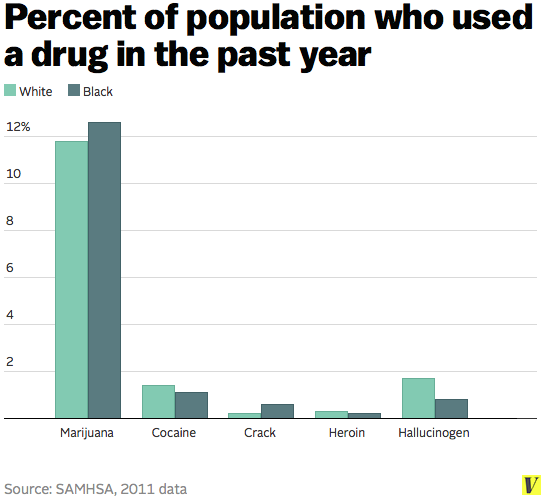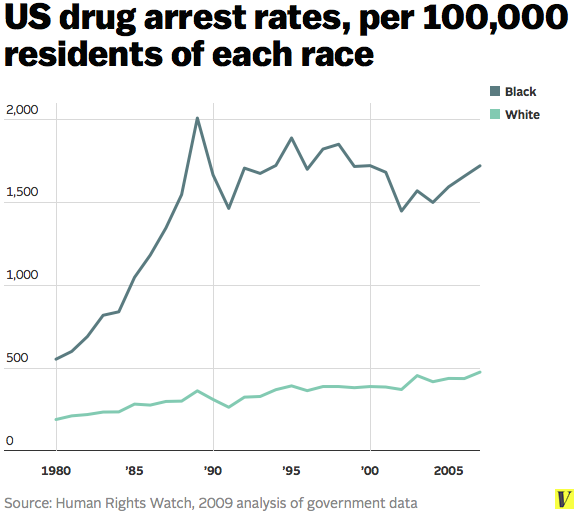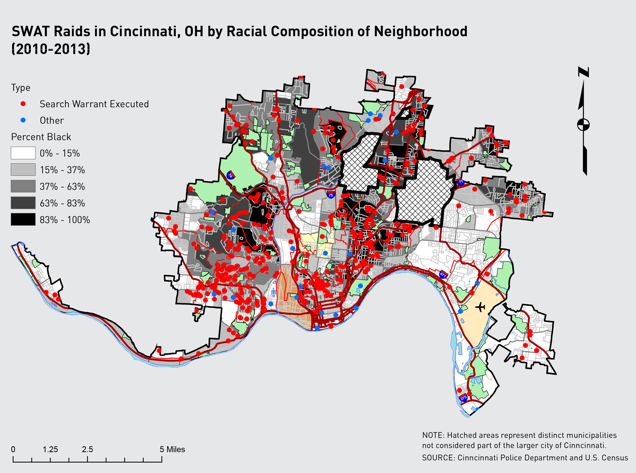/cdn.vox-cdn.com/uploads/chorus_image/image/36114340/170749658.0.jpg)
The New York Times Editorial Board on Saturday came out in favor of nationwide marijuana legalization, citing in part the racist enforcement of marijuana prohibition laws.
It's true black people are arrested for marijuana at far higher rates than their white counterparts, but the racially biased execution of the war on drugs doesn't end there. Many drug policy experts point to the racially lopsided enforcement of the entire war on drugs as one reason all drugs, not just marijuana, should be decriminalized and even legalized.
1) Black people are arrested for drugs at disproportionate rates
White and black people report using drugs at similar rates, according to the latest data from the Substance Abuse and Mental Health Services Administration. There's some variance from drug to drug: white people report more often using cocaine, heroin, and hallucinogens, while black people report more marijuana and crack cocaine use.

These statistics underline why critics decry the war on drugs as racist. Although black people are much more likely to be sent to jail for drug possession, they're not more likely to use drugs.
A 2009 report from Human Rights Watch found black people are much more likely to be arrested for drugs. In 2007, black people were 3.6 times more likely to be arrested for drugs than white people.

Human Rights Watch found more than four in five arrests in the war on drugs are for mere possession, while the rest are for sales. That suggests police are targeting drug users, not traffickers.
A common defense for these types of statistics is that drug charges are often used to lock people up for other crimes. As Vox's Dara Lind wrote, "One theory for this: In many cases, police have used drug crime as a proxy for violent crime. It's much easier for a prosecutor to guarantee a conviction on a drug charge — where there's physical evidence that the defendant had drugs — than on a violent charge, where proving what happened is more complicated. And police target drug enforcement in high-violence neighborhoods, which are overwhelmingly black and Latino."
Whatever the intention, the disproportionate arrests and incarceration rates — supposedly for violent crimes that apparently can't even be proven in court — have clearly detrimental effects on minority communities. A study published in the journal Sociological Science found boys with imprisoned fathers are much less likely to possess the behavioral skills needed to succeed in school by the age of five, starting them on a vicious path known as the school-to-prison pipeline.
2) Once convicted, black drug offenders get longer sentences than white drug offenders
Drug sentences for black men were 13.1 percent longer than drug sentences for white men between 2007 and 2009, according to a 2012 report from the US Sentencing Commission.
That disparity has been mostly true throughout recent history. Black men received 9.1 percent longer drug sentences between 2005 and 2007 and 9.2 percent longer drug sentences between 1998 and 2003. There was no statistically significant difference in drug sentences for black and white men in 2003 and 2004.
3) Mandatory minimum sentences target a drug more often used by black people
Mandatory minimum sentences were established in the 1980s when politicians touted the so-called crack epidemic to show off tough-on-crime stances. But these sentences are set in a way that could target black drug offenders more than white drug offenders.
Take, for instance, the mandatory minimum sentence threshold for crack versus cocaine. Someone would need to possess nearly 18 times more cocaine than crack to get a five-year mandatory minimum sentence.

Black people use crack at higher rates than white people, while white people use cocaine at higher rates than black people. So the tougher sentences on crack make it much easier for law enforcement to come down on black drug offenders.
Crack and cocaine are pharmacologically identical drugs. The difference is crack is mostly smoked, while cocaine is traditionally snorted. Smoking can make the effect more potent, faster acting, and potentially unhealthier, but both drugs essentially have the same effects in the long-term.
4) SWAT team raids disproportionately target black neighborhoods
SWAT raids are much more common in black neighborhoods than white neighborhoods, according to a recent report from the American Civil Liberties Union.
As one example, the ACLU mapped SWAT raids in Cincinnati between 2010 and 2013. The predominantly black neighborhoods are sometimes fully covered in red dots, while some mostly white neighborhoods have no dots at all:

The ACLU found that 62 percent of SWAT raids are used for drug searches, and drug-related SWAT deployments primarily impacted people of color. Combined, the statistics suggest enforcement in the war on drugs hits black people — and their neighborhoods — the hardest.
For more information on marijuana legalization, read Vox's full explainer and watch the video below: